This is an old revision of this page, as edited by 164.143.240.34 (talk) at 05:13, 3 May 2010 (A lot of the information here, which was false, did not contain citings. Though I've changed things and cited them coutless times, someone keeps changing it back to false representation of history). The present address (URL) is a permanent link to this revision, which may differ significantly from the current revision.
Revision as of 05:13, 3 May 2010 by 164.143.240.34 (talk) (A lot of the information here, which was false, did not contain citings. Though I've changed things and cited them coutless times, someone keeps changing it back to false representation of history)(diff) ← Previous revision | Latest revision (diff) | Newer revision → (diff)| Republic of UzbekistanO‘zbekiston Respublikasi Ўзбекистон Республикаси | |
|---|---|
 Flag
Flag
 Coat of arms
Coat of arms
| |
| Anthem: National Anthem of the Republic of Uzbekistan | |
 | |
| Capitaland largest city | Tashkent |
| Official languages | Uzbek |
| Recognised regional languages | Karakalpak |
| Language for inter-ethnic communication | Russian |
| Ethnic groups | 80.0% Uzbek 5.5% Russian 5.0%-5.5% (Official Uzbek Statistics), (30% Foltz, Cordell, Jonson) Tajik 3.0% Kazakh 2.5% Karakalpak 1.5% Tatar 2.5% Others |
| Demonym(s) | Uzbekistani; also Uzbek |
| Government | Authoritarian State |
| • President | Islam Karimov |
| • Prime Minister | Shavkat Mirziyoyev |
| Independence from the Soviet Union | |
| • Formation | 1747 |
| • Uzbek SSR | 27 October 1924 |
| • Declared | 1 September 1991 |
| • Recognized | 8 December 1991 |
| • Completed | 25 December 1991 |
| Area | |
| • Total | 447,400 km (172,700 sq mi) (56th) |
| • Water (%) | 4.9 |
| Population | |
| • 2009 estimate | 27,606,007 (45th) |
| • Density | 61.4/km (159.0/sq mi) (136th) |
| GDP (PPP) | 2009 estimate |
| • Total | $78.338 billion |
| • Per capita | $2,806 |
| GDP (nominal) | 2009 estimate |
| • Total | $32.816 billion |
| • Per capita | $1,175 |
| Gini (2000) | 26.8 Error: Invalid Gini value (95th) |
| HDI (2007) | Error: Invalid HDI value (119th) |
| Currency | Uzbekistan som (O'zbekiston so'mi) (UZS) |
| Time zone | UTC+5 (UZT) |
| • Summer (DST) | UTC+5 (not observed) |
| Drives on | Right |
| Calling code | 998 |
| ISO 3166 code | UZ |
| Internet TLD | .uz |
Uzbekistan, officially the Republic of Uzbekistan (Template:Lang-uz‘zbekiston Respublikasi or Ўзбекистон Республикаси), is a [[Landlocked country#Doubly landlocked country|doubly landlocked country in Central Asia, formerly part of the Soviet Union. It shares borders with Kazakhstan to the west and to the north, Kyrgyzstan and Tajikistan to the east, and Afghanistan and Turkmenistan to the south.
Once part of the Göktürk and later Timurid empires, the region was conquered in the early 16th century by Uzbek nomads, who spoke an Eastern Turkic language. Most of Uzbekistan’s population today belong to the Uzbek ethnic group and speak the Uzbek language, one of the family of Turkic languages.
Uzbekistan (then part of Turkestan) was incorporated into the Russian Empire in the 19th century and in 1924 became a constituent republic of the Soviet Union, known as the Uzbek Soviet Socialist Republic (Uzbek SSR). It has been an independent republic since December 1991.
The Uzbek economy relies mainly on commodity production, including cotton, gold, uranium, potassium, and natural gas. Despite the declared objective of transition to a market economy, Uzbekistan continues to maintain rigid economic controls, which often repel foreign investors. The policy of gradual, strictly controlled transition has nevertheless produced beneficial results in the form of economic recovery after 1995. Uzbekistan's domestic policies on human rights and individual freedoms are often criticised by international organizations. In Uzbekistan about 45% of the population live on less than US$1.25 per day.
Geography
Main article: Geography of Uzbekistan See also: List of cities in Uzbekistan

Uzbekistan has an area of Template:Km2 to mi2. It is the 56th largest country in the world by area and the 42nd by population. Among the CIS countries, it is the 5th largest by area and the 3rd largest by population.
Uzbekistan stretches Template:Km to mi from west to east and Template:Km to mi from north to south. Bordering Kazakhstan and the Aral Sea to the north and northwest, Turkmenistan to the southwest, Tajikistan to the southeast, and Kyrgyzstan to the northeast, Uzbekistan is not only one of the larger Central Asian states but also the only Central Asian state to border all the other four. Uzbekistan also shares a short border (less than 150 km or 93 mi) with Afghanistan to the south.
Uzbekistan is a dry, landlocked country; it is one of two doubly landlocked countries in the world, i.e., a country completely surrounded by landlocked countries – the other being Liechtenstein. Less than 10% of its territory is intensively cultivated irrigated land in river valleys and oases. The rest is vast desert (Kyzyl Kum) and mountains.
The highest point in Uzbekistan is the Khazret Sultan, located at Template:M to ft above sea level, located in the southern part of the Gissar Range in Surkhandarya Province, on the border with Tajikistan, just north-west of Dushanbe (formerly called Peak of the 22nd Congress of the Communist Party).
The climate in the Republic of Uzbekistan is continental, with little precipitation expected annually (100–200 millimeters, or 3.9–7.9 inches). The average summer high temperature tends to be 40 °C (104 °F), while the average winter low temperature is around −23 °C (−9 °F).
Major cities include Bukhara, Samarkand, Namangan and the capital Tashkent.
History
Main article: History of Uzbekistan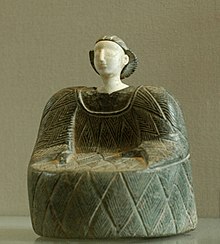

The earliest Bronze Age colonists of the Tarim Basin were Caucasian people of Caucasoid physical type who entered probably from the north and west, and probably spoke languages that could be classified as Pre- or Proto-Tocharian, ancestral to the Indo-European Tocharian languages documented later in the Tarim Basin. These early settlers occupied the northern and eastern parts of the Tarim Basin, where their graves have yielded mummies dated about 1800 B.C. They did not arrive from Europe, but probably had lived earlier near the Altai Mountains, where their ancestors had participated in a cultural world centered on the eastern steppes of central Eurasia, including modern northeastern Kazakhstan, Kyrgyzstan, and Tajikistan. At the eastern end of the Tarim Basin, people of Mongoloid physical type began to be buried in cemeteries such as Yanbulaq some centuries later, during the later second or early first millennium B.C. About the same time, Iranic-speaking people moved into the Tarim Basin from the steppes to the west. Their linguistic heritage and perhaps their physical remains are found in the southern and western portions of the Tarim. These three populations interacted, as the linguistic and archaeological evidence reviewed by Mallory and Mair makes clear, and then Turkic peoples arrived and were added to the mix.‘The Tarim Mummies - J.P. Mallory and Victor Mair New York: Thames and Hudson, 2000’ The first people known to have occupied Central Asia were Turkic nomads who arrived from the northern grasslands of what is now Uzbekistan sometime in the first millennium BC. These nomads settled in Central Asia and began to build an extensive irrigation system along the rivers of the region. At this time, cities such as Bukhara and Samarkand began to appear as centers of government and culture. By the 5th century BC, the Bactrian, Soghdian, and Tokharian states dominated the region. As China began to develop its silk trade with the West, Central Asian cities took advantage of this commerce by becoming centers of trade. Using an extensive network of cities and settlements in the province of Mawarannahr (a name given the region after the Arab conquest) in Uzbekistan and farther east in what is today China's Xinjiang Uygur Autonomous Region, the Soghdian intermediaries became the wealthiest of these merchants. Because of this trade on what became known as the Silk Route, Bukhara and Samarkand eventually became extremely wealthy cities, and at times Mawarannahr was one of the most influential and powerful provinces of antiquity.
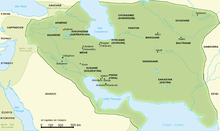

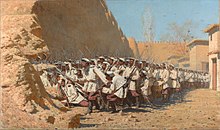
Alexander the Great conquered Sogdiana and Bactria in 327 BC, marrying Roxana, daughter of a local Bactrian chieftain. The conquest was supposedly of little help to Alexander as popular resistance was fierce, causing Alexander's army to be bogged down in the region that became the northern part of Hellenistic Greco-Bactrian Kingdom. For many centuries the region of Uzbekistan was ruled by Turkic empires, including the Kara-Khanid and Ghaznavids Empires.
The Mongol conquest under Genghis Khan during the 13th century, would bring about a dramatic change to the region. The conquest and widespread integration of the Mongols into the region brought many social, economic, cultural, and political changes to Central Asia. The mongols were met with fierce resitance by the ruler of the Turkic Khwarezmid Empire Jelal ad-Din Manguberdi.
Following the death of Genghis Khan in 1227, his empire was divided among his four sons and his family members. Despite the potential for serious fragmentation, Mongol law of the Mongol Empire maintained orderly succession for several more generations, and control of most of Mawarannahr stayed in the hands of direct descendants of Chagatai Khan, the second son of Genghis Khan. Orderly succession, prosperity, and internal peace prevailed in the Chaghatai lands, and the Mongol Empire as a whole remained strong and united.
In the early fourteenth century, however, as the empire began to break up into its constituent parts, the Chaghatai territory also was disrupted as the princes of various tribal groups competed for influence. One tribal chieftain, Timur (Tamerlane), emerged from these struggles in the 1380s as the dominant force in Mawarannahr. Although he was not a descendant of Chinggis, Timur became the de facto ruler of Mawarannahr and proceeded to conquer all of western Central Asia, Iran, Asia Minor, and the southern steppe region north of the Aral Sea. He also invaded Russia and India before dying during an invasion of China in 1405.
Timur initiated the last flowering of Mawarannahr by gathering in his capital, Samarqand, numerous artisans and scholars from the lands he had conquered. By supporting such people, Timur imbued his empire with a very rich culture. During Timur's reign and the reigns of his immediate descendants, a wide range of religious and palatial construction projects were undertaken in Samarqand and other population centres. Timur also patronized scientists and artists; his grandson Ulugh Beg was one of the world's first great astronomers. It was during the Timurid dynasty that Turkic, in the form of the Chaghatai dialect, became a literary language in its own right in Mawarannahr—although the Timurids also patronized writing in Persian. Until then only Arabic and Persian had been used in the region. The greatest Chaghataid writer, Alisher Navoi, was active in the Uzbek city of Herat, now in northwestern Afghanistan, in the second half of the fifteenth century.
The Timurid state quickly broke into two halves after the death of Timur. The chronic internal fighting of the Timurids attracted the attention of the Uzbek nomadic tribes living to the north of the Aral Sea. In 1501 the Uzbeks began a wholesale invasion of Mawarannahr.
In the nineteenth century, the Russian Empire began to expand and spread into Central Asia. By 1912 there were 210,306 Russians living in Uzbekistan. The "Great Game" period is generally regarded as running from approximately 1813 to the Anglo-Russian Convention of 1907. Following the Bolshevik Revolution of 1917, a second, less intensive phase followed. At the start of the nineteenth century, there were some 2,000 miles (3,200 km) separating British India and the outlying regions of Tsarist Russia. Much of the land in between was unmapped.
By the beginning of the twentieth century, Central Asia was firmly in the hands of Russia, and despite some early resistance to Bolsheviks, Uzbekistan and the rest of Central Asia became a part of the Soviet Union. On 27 October 1924 the Uzbek Soviet Socialist Republic was created. On 31 August 1991, Uzbekistan declared independence, marking 1 September as a national holiday.
The country is now the world's second-largest exporter of cotton, and it is developing its mineral and petroleum reserves.
Politics
Main article: Politics of Uzbekistan
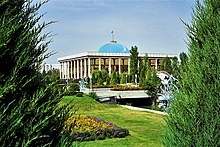
Constitutionally, the Government of Uzbekistan provides for democracy. The first elections of the Oliy Majlis (Parliament) were held under a resolution adopted by the 16th Supreme Soviet in 1994. In that year, the Supreme Soviet was replaced by the Oliy Majlis. Since then Uzbekistan has been progressing well toward an electoral system, holding presidential and parliamentarian elections on regular basis under a multi-party system. The third elections for the bicameral 150-member Oliy Majlis for five-year term, comprising of the Legislative Chamber and the 100-member Senate, were held on 27 December 2009, after the second elections that were held in December 2004-2005. The Oliy Majlis was unicameral up to 2004. Its strength increased from 69 deputies (members) in 1994 to 120 in 2004-5 and presently to 150.
The executive holds a great deal of power, and the legislature and judiciary have little power to shape laws. Under terms of a December 27, 1995 referendum, Islam Karimov's first term was extended. Another national referendum was held 27 January 2002 to extend the Constitutional Presidential term from 5 years to 7 years.
The referendum passed, and Karimov's term was extended by act of the parliament to December 2007. Most international observers refused to participate in the process and did not recognize the results, dismissing them as not meeting basic standards. The 2002 referendum also included a plan to create a bicameral parliament, consisting of a lower house (the Oliy Majlis) and an upper house (Senate). Members of the lower house are to be "full time" legislators. Elections for the new bicameral parliament took place on 26 December, but no truly independent opposition candidates or parties were able to take part.
The OSCE limited observation mission concluded that the elections fell significantly short of OSCE commitments and other international standards for democratic elections. Several political parties have been formed with government approval. Similarly, although multiple media outlets (radio, TV, newspaper) have been established, these either remain under government control or rarely broach political topics. Independent political parties were allowed to organise, recruit members and hold conventions and press conferences, but they have been denied registration under restrictive registration procedures.
Human rights
Main article: Human rights in UzbekistanThe Constitution of the Republic of Uzbekistan asserts that "democracy in the Republic of Uzbekistan shall be based upon common human principles, according to which the highest value shall be the human being, his life, freedom, honour, dignity and other inalienable rights."
However, non-governmental human rights watchdogs, such as IHF, Human Rights Watch, Amnesty International, as well as United States Department of State and Council of the European Union define Uzbekistan as "an authoritarian state with limited civil rights" and express profound concern about "wide-scale violation of virtually all basic human rights". According to the reports, the most widespread violations are torture, arbitrary arrests, and various restrictions of freedoms: of religion, of speech and press, of free association and assembly. The reports maintain that the violations are most often committed against members of religious organizations, independent journalists, human rights activists and political activists, including members of the banned opposition parties. In 2005, Uzbekistan was included into Freedom House's "The Worst of the Worst: The World's Most Repressive Societies."
The official position is summarised in a memorandum "The measures taken by the government of the Republic of Uzbekistan in the field of providing and encouraging human rights" and amounts to the following: the government does everything that is in its power to protect and to guarantee the human rights of Uzbekistan's citizens. Uzbekistan continuously improves its laws and institutions in order to create a more humane society. Over 300 laws regulating the rights and basic freedoms of the people have been passed by the parliament. For instance, an office of Ombudsman was established in 1996. On 2 August 2005, President Islam Karimov signed a decree that was to abolish capital punishment in Uzbekistan on 1 January 2008.
The 2005 civil unrest in Uzbekistan, which resulted in several hundred people being killed, is viewed by many as a landmark event in the history of human rights abuse in Uzbekistan, A concern has been expressed and a request for an independent investigation of the events has been made by the United States, European Union, the UN, the OSCE Chairman-in-Office and the OSCE Office for Democratic Institutions and Human Rights. The government of Uzbekistan is accused of unlawful termination of human life and of denying its citizens freedom of assembly and freedom of expression. The government vehemently rebuffs the accusations, maintaining that it merely conducted an anti-terrorist operation, exercising only necessary force. In addition, some officials claim that "an information war on Uzbekistan has been declared" and the human rights violations in Andijan are invented by the enemies of Uzbekistan as a convenient pretext for intervention into the country's internal affairs.
Uzbekistan also does not allow Tajiks to teach their youth in their native language. There have been cases of destroying great Tajiki (Farsi) literary works.
Provinces and districts
Main articles: Provinces of Uzbekistan and Districts of UzbekistanUzbekistan is divided into twelve provinces (viloyatlar, singular viloyat, compound noun viloyati e.g., Toshkent viloyati, Samarqand viloyati, etc.), one autonomous republic (respublika, compound noun respublikasi e.g. Qaraqalpaqstan Avtonom Respublikasi, Karakalpakistan Autonomous Republic, etc.), and one independent city (shahar. compound noun shahri, e.g., Toshkent shahri). Names are given below in the Uzbek language, although numerous variations of the transliterations of each name exist.

| Division | Capital City | Area (km²) |
Population (2008) | Key |
|---|---|---|---|---|
| Buxoro Viloyati | Buxoro (Bukhara) | 39,400 | 1,576,800 | 3 |
| Jizzax Viloyati | Jizzax | 20,500 | 1,090,900 | 5 |
| Navoiy Viloyati | Navoiy | 110,800 | 834,100 | 7 |
| Qashqadaryo Viloyati | Qarshi | 28,400 | 2,537,600 | 8 |
| Samarqand Viloyati | Samarqand | 16,400 | 3,032,000 | 9 |
| Sirdaryo Viloyati | Guliston | 5,100 | 698,100 | 10 |
| Surxondaryo Viloyati | Termiz | 20,800 | 2,012,600 | 11 |
| Toshkent Viloyati | Toshkent (Tashkent) | 15,300 | 2,537,500 | 12 |
| Toshkent Shahri | Toshkent (Tashkent) | ??? | 2,192,700 | 1 |
| Fergana Valley Region | ||||
| Farg'ona Viloyati | Farg'ona (Fergana) | 6,800 | 2,997,400 | 4 |
| Andijon Viloyati | Andijon | 4,200 | 2,477,900 | 2 |
| Namangan Viloyati | Namangan | 7,900 | 2,196,200 | 6 |
| Karakalpakstan Region | ||||
| Xorazm Viloyati | Urganch | 6,300 | 1,517,600 | 13 |
| Qaraqalpaqstan Respublikasi | Nukus | 160,000 | 1,612,300 | 14 |
The statistics for Toshkent Viloyati also include the statistics for Toshkent Shahri.
The provinces are further divided into districts (tuman).
Economy
Main article: Economy of Uzbekistan

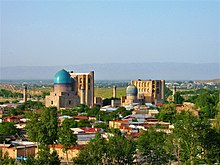
Along with many Commonwealth of Independent States economies, Uzbekistan's economy declined during the first years of transition and then recovered after 1995, as the cumulative effect of policy reforms began to be felt. It has shown robust growth, rising by 4% per year between 1998 and 2003 and accelerating thereafter to 7%-8% per year. According to IMF estimates, the GDP in 2008 will be almost double its value in 1995 (in constant prices). Since 2003 annual inflation rates averaged less than 10%.
Uzbekistan has a very low GNI per capita (US$610 in current dollars in 2006, giving a PPP equivalent of US$2,250). By GNI per capita in PPP equivalents Uzbekistan ranks 169 among 209 countries; among the 12 CIS countries, only Kyrgyzstan and Tajikistan had lower GNI per capita in 2006. Economic production is concentrated in commodities: Uzbekistan is now the world's sixth-largest producer and second-largest exporter of cotton, as well as the seventh largest world producer of gold. It is also a regionally significant producer of natural gas, coal, copper, oil, silver and uranium.
Agriculture employs 28% of Uzbekistan's labour force and contributes 24% of its GDP (2006 data). While official unemployment is very low, underemployment – especially in rural areas – is estimated to be at least 20%. Still, at cotton-harvest time, all students and teachers are mobilized as unpaid labour to help in the fields. The use of child labour in Uzbekistan has led several companies, including Tesco, C&A, Marks & Spencer, Gap, and H&M, to boycott Uzbek cotton.
Facing a multitude of economic challenges upon acquiring independence, the government adopted an evolutionary reform strategy, with an emphasis on state control, reduction of imports and self-sufficiency in energy. Since 1994, the state-controlled media have repeatedly proclaimed the success of this "Uzbekistan Economic Model" and suggested that it is a unique example of a smooth transition to the market economy while avoiding shock, pauperism and stagnation.
The gradualist reform strategy has involved postponing significant macroeconomic and structural reforms. The state in the hands of the bureaucracy has remained a dominant influence in the economy. Corruption permeates the society and grows more rampant over time: Uzbekistan's 2005 Corruption Perception Index was 137 out of 159 countries, whereas in 2007 Uzbekistan is at the very bottom of the ranking, 175 out of 179. A February 2006 report on the country by the International Crisis Group suggests that revenues earned from key exports, especially cotton, gold, corn and increasingly gas, are distributed among a very small circle of the ruling elite, with little or no benefit for the populace at large.
According to the Economist Intelligence Unit, "the government is hostile to allowing the development of an independent private sector, over which it would have no control". Thus, the national bourgeoisie in general, and the middle class in particular, are marginalised economically and, consequently, politically.
The economic policies have repelled foreign investment, which is the lowest per capita in the CIS. For years, the largest barrier to foreign companies entering the Uzbekistan market has been the difficulty of converting currency. In 2003, the government accepted the obligations of Article VIII under the International Monetary Fund. providing for full currency convertibility. However, strict currency controls and the tightening of borders have lessened the effect of this measure.
Uzbekistan experienced rampant inflation of around 1000% per year immediately after independence (1992–1994). Stabilisation efforts implemented with guidance from the IMF paid off. The inflation rates were brought down to 50% in 1997 and then to 22% in 2002. Since 2003 annual inflation rates averaged less than 10%. Tight economic policies in 2004 resulted in a drastic reduction of inflation to 3.8% (although alternative estimates based on the price of a true market basket, put it at 15%). The inflation rates moved up to 6.9% in 2006 and 7.6% in 2007 but have remained in the single-digit range.
The government of Uzbekistan restricts foreign imports in many ways, including high import duties. Excise taxes are applied in a highly discriminatory manner to protect locally produced goods. Official tariffs are combined with unofficial, discriminatory charges resulting in total charges amounting to as much as 100 to 150% of the actual value of the product, making imported products virtually unaffordable. Import substitution is an officially declared policy and the government proudly reports a reduction by a factor of two in the volume of consumer goods imported. A number of CIS countries are officially exempt from Uzbekistan import duties.
The Republican Stock Exchange (RSE) 'Tashkent' opened in 1994. It houses a securities exchange, real estate traders, the national investment fund and the national securities depositary. It does not trade all joint-stock companies each month, and therefore market capitalisation varies widely.
Uzbekistan's external position has been strong since 2003. Thanks in part to the recovery of world market prices of gold and cotton (the country's key export commodities), expanded natural gas and some manufacturing exports, and increasing labour migrant transfers, the current account turned into a large surplus (between 9% and 11% of GDP from 2003 to 2005) and foreign exchange reserves, including gold, more than doubled to around US$3 billion.
Demographics
Main article: Demographics of Uzbekistan
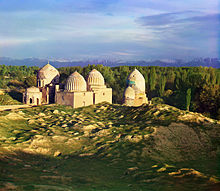
Uzbekistan is Central Asia's most populous country. Its 27.7 million people (July 2007 estimate) comprise nearly half the region's total population.
The population of Uzbekistan is very young: 34.1% of its people are younger than 14 (2008 estimate). According to official sources, Uzbeks comprise a majority (80%) of the total population. Other ethnic groups include Russians 5.5%, Tajiks 5%(official estimate and disputed), Kazakhs 3%, Karakalpaks 2.5% and Tatars 1.5% (1996 estimates).
There is some controversy about the percentage of the Tajik population. While official state numbers from Uzbekistan put the number at 5%, the number is said to be an understatement and some Western scholars put the number up to 20%-30%.
Uzbekistan has an ethnic Korean population that was forcibly relocated to the region by Stalin from the Soviet Far East in 1937–1938. There are also small groups of Armenians in Uzbekistan, mostly in Tashkent and Samarkand. The nation is 88% Muslim (mostly Sunni, with a 5% Shi'a minority), 9% Eastern Orthodox and 3% other faiths. The U.S. State Department's International Religious Freedom Report 2004 reports that 0.2% of the population are Buddhist (these being ethnic Koreans). The Bukharian Jews have lived in Central Asia, mostly in Uzbekistan, for thousands of years. There were 94,900 Jews in Uzbekistan in 1989 (about 0.5% of the population according to the 1989 census), but now, since the collapse of the USSR, most Central Asian Jews left the region for the United States or Israel. Fewer than 5,000 Jews remained in Uzbekistan in 2007.
During the Soviet period, Russians and Ukrainians constituted more than half the population of Tashkent. The country counted nearly 1.5 million Russians, 12.5% of the population, in the 1970 census. After the collapse of the Soviet Union, significant emigration of ethnic Russians has taken place, mostly for economic reasons.
In the 1940s, the Crimean Tatars, along with the Germans, Chechens, Greeks, Turks, Kurds and many other nationalities were deported to Central Asia. Approximately 100,000 Crimean Tatars continue to live in Uzbekistan. In 1974, there were 35,000 Greeks in Tashkent. Today, 12,000 remain. The majority of Meskhetian Turks left Uzbekistan after 1989.
At least 10% of Uzbekistan's labour force works abroad (mostly in Russia and Kazakhstan).
Uzbekistan has a 99.3% literacy rate among adults older than 15 (2003 estimate), which is attributable to the free and universal education system of the Soviet Union.
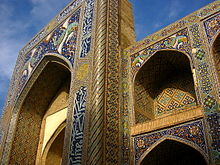
Religion
Main article: Islam in UzbekistanIslam is by far the dominant religion in Uzbekistan, as Muslims constitute 90% of the population according to a 2009 US State Department release. Approximately 5% of the population are Russian Orthodox Christians. An estimated 93,000 Jews were once present in the country.
Despite its predominance, the practice of Islam is far from monolithic. Many versions of the faith have been practiced in Uzbekistan. The conflict of Islamic tradition with various agendas of reform or secularisation throughout the 20th century has left the outside world with a confused notion of Islamic practices in Central Asia.
In Uzbekistan the end of Soviet power did not bring an upsurge of fundamentalism, as many had predicted, but rather a gradual reacquaintance with the precepts of the faith. However after 2000, there seems to be a rise of support in favour of the Islamists.
Although constitutionally maintaining rights to freedom of religion, Uzbekistan maintains a ban on all religious activities not approved by that state. See: Human Rights; Freedom of Religion, Uzbekistan
Languages
Main article: Uzbek languageThe Uzbek language is the only official state language. The Tajik language is widespread in the cities of Bukhara and Samarqand because of their relatively large population of ethnic Tajiks.
Russian is an important language for interethnic communication, especially in the cities, including much day-to-day technical, scientific, governmental and business use. Russian is the main language of over 14% of the population and is spoken as a second language by many more. The use of Russian in remote rural areas has always been limited, and today school children have no proficiency in Russian even in urban centres. However, it was reported in 2003 that over half of the population could speak Russian, and a renewed close political relationship between Russia and Uzbekistan have meant that official discouragement of Russian has dropped off sharply.
In 1992 Uzbekistan officially shifted back to Latin script, but many signs and notices (including official government boards in the streets) are still written in Uzbek Cyrillic script that had been used in Uzbek SSR since 1940. Computers as a rule operate using the "Uzbek Cyrillic" keyboard, and Latin script is reportedly composed using the standard English keyboard.
Communications
Main article: Communications in UzbekistanAccording to the official source report, as of 10 March 2008, the number of cellular phone users in Uzbekistan reached 7 million, up from 3.7 million on 1 July 2007. The largest mobile operator in terms of number of subscribers is MTS-Uzbekistan (former Uzdunrobita and part of Russian Mobile TeleSystems) and it is followed by Beeline (part of Russia's Beeline) and UCell (ex Coscom) (originally part of the U.S. MCT Corp., now a subsidiary of the Nordic/Baltic telecommunication company TeliaSonera AB).
As of 1 July 2007, the estimated number of internet users was 1.8 million, according to UzACI.
Transportation
Main article: Transportation in Uzbekistan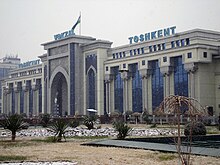
Tashkent, the nation's capital and largest city, has a three-line rapid transit system built in 1977, and expanded in 2001 after ten years' independence from the Soviet Union. Uzbekistan is currently the only country in Central Asia with a subway system, which is promoted as one of the cleanest systems in the former Soviet Union. The stations are exceedingly ornate. For example, the station Metro Kosmonavtov built in 1984 is decorated using a space travel theme to recognise the achievements of mankind in space exploration and to commemorate the role of Vladimir Dzhanibekov, the Soviet cosmonaut of Uzbek origin. A statue of Vladimir Dzhanibekov stands near one of the station's entrances.
There are government-operated trams, buses and trolley buses running across the city. There are also many taxis, both registered and unregistered. Uzbekistan has car-producing plants which produce modern cars. The car production is supported by the government and the Korean auto company Daewoo. The Uzbek government acquired a 50% stake in Daewoo in 2005 for an undisclosed sum, and in May 2007 UzDaewooAuto, the car maker, signed a strategic agreement with General Motors-Daewoo Auto and Technology (GMDAT). The government also bought a stake in Turkey's Koc in SamKocAuto, a producer of small buses and lorries. Afterwards, it signed an agreement with Isuzu Motors of Japan to produce Isuzu buses and lorries.
Train links connect many towns within Uzbekistan, as well as neighboring former republics of the Soviet Union. Moreover, after independence two fast-running train systems were established. There is also a large airplane plant that was built during the Soviet era – Tashkent Chkalov Aviation Manufacturing Plant or ТАПОиЧ in Russian. The plant originated during World War II, when production facilities were evacuated south and east to avoid capture by advancing Nazi forces. Until the late 1980s, the plant was one of the leading airplane production centers in the USSR, but with collapse of the Soviet Union its manufacturing equipment became outdated, and most of the workers were laid off. Now it produces only a few planes a year, but with interest from Russian companies growing in it, there are rumours of production-enhancement plans.
Military
Main article: Military of Uzbekistan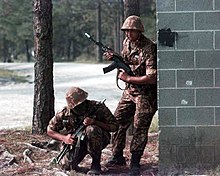
Uzbekistan possesses the largest military force in the Central Asian region having around 65,000 people in uniform. Its structure is inherited from the Soviet armed forces, although it is moving rapidly toward a fully restructured organisation, which will eventually be built around light and Special Forces. The Uzbekistan Armed Forces equipment is not modern, and training, while improving, is neither uniform nor adequate for its new mission of territorial security.
The government has accepted the arms control obligations of the former Soviet Union, acceded to the Nuclear Non-Proliferation Treaty (as a non-nuclear state), and supported an active program by the U.S. Defense Threat Reduction Agency (DTRA) in western Uzbekistan (Nukus and Vozrozhdeniye Island). The Government of Uzbekistan spends about 3.7% of GDP on the military but has received a growing infusion of Foreign Military Financing (FMF) and other security assistance funds since 1998.
Following the 11 September 2001 terrorist attacks in the U.S., Uzbekistan approved the U.S. Central Command's request for access to a vital military air base, Karshi-Khanabad Airbase, in southern Uzbekistan. However Uzbekistan demanded that the U.S. withdraw from the airbases after the Andijan massacre and the U.S. reaction to this massacre. The last US troops left Uzbekistan in November 2005.
Foreign relations
Main articles: Foreign relations of Uzbekistan and International organization membership of Uzbekistan
Uzbekistan joined the Commonwealth of Independent States in December 1991. However, it is opposed to reintegration and withdrew from the CIS collective security arrangement in 1999. Since that time, Uzbekistan has participated in the CIS peacekeeping force in Tajikistan and in UN-organized groups to help resolve the Tajikistan and Afghanistan conflicts, both of which it sees as posing threats to its own stability.
Previously close to Washington (which gave Uzbekistan half a billion dollars in aid in 2004, about a quarter of its military budget), the government of Uzbekistan has recently restricted American military use of the airbase at Karshi-Khanabad for air operations in neighboring Afghanistan. Uzbekistan was an active supporter of U.S. efforts against worldwide terrorism and joined the coalitions that have dealt with both Afghanistan and Iraq.
The relationship between Uzbekistan and the United States began to deteriorate after the so-called "colour revolutions" in Georgia and Ukraine (and to a lesser extent Kyrgyzstan). When the U.S. joined in a call for an independent international investigation of the bloody events at Andijon, the relationship took an additional nosedive, and President Islam Karimov changed the political alignment of the country to bring it closer to Russia and China, countries which chose not to criticise Uzbekistan's leaders for their alleged human rights violations.
In late July 2005, the government of Uzbekistan ordered the United States to vacate an air base in Karshi-Kanabad (near Uzbekistan's border with Afghanistan) within 180 days. Karimov had offered use of the base to the U.S. shortly after 9/11. It is also believed by some Uzbeks that the protests in Andijan were brought about by the U.K. and U.S. influences in the area of Andijan. This is another reason for the hostility between Uzbekistan and the West.
Uzbekistan is a member of the United Nations (UN) (since 2 March 1992), the Euro-Atlantic Partnership Council (EAPC), Partnership for Peace (PfP), and the Organisation for Security and Cooperation in Europe (OSCE). It belongs to the Organisation of the Islamic Conference (OIC) and the Economic Cooperation Organisation (ECO) (comprising the five Central Asian countries, Azerbaijan, Turkey, Iran, Afghanistan, and Pakistan). In 1999, Uzbekistan joined the GUAM alliance (Georgia, Ukraine, Azerbaijan and Moldova), which was formed in 1997 (making it GUUAM), but pulled out of the organization in 2005.
Uzbekistan is also a member of the Shanghai Cooperation Organisation (SCO) and hosts the SCO’s Regional Anti-Terrorist Structure (RATS) in Tashkent. Uzbekistan joined the new Central Asian Cooperation Organisation (CACO) in 2002. The CACO consists of Uzbekistan, Tajikistan, Kazakhstan and Kyrgyzstan. It is a founding member of, and remains involved in, the Central Asian Union, formed with Kazakhstan and Kyrgyzstan, and joined in March 1998 by Tajikistan.
In September 2006, UNESCO presented Islam Karimov an award for Uzbekistan's preservation of its rich culture and traditions. Despite criticism, this seems to be a sign of improving relationships between Uzbekistan and the West.
The month of October 2006 also saw a decrease in the isolation of Uzbekistan from the West. The EU announced that it was planning to send a delegation to Uzbekistan to talk about human rights and liberties, after a long period of hostile relations between the two. Although it is equivocal about whether the official or unofficial version of the Andijan Massacre is true, the EU is evidently willing to ease its economic sanctions against Uzbekistan. Nevertheless, it is generally assumed among Uzbekistan's population that the government will stand firm in maintaining its close ties with the Russian Federation and in its theory that the 2004–2005 protests in Uzbekistan were promoted by the USA and UK.
Culture
Main article: Culture of Uzbekistan See also: Music of Uzbekistan, Kurash, Islam in Uzbekistan, and Scout Association of Uzbekistan
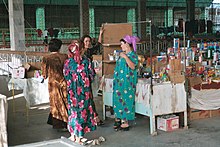


Uzbekistan has a wide mix of ethnic groups and cultures, with the Uzbek being the majority group. In 1995 about 71% of Uzbekistan's population was Uzbek. The chief minority groups were Russians (8%), Tajiks (5–30%), Kazaks (4%), Tatars (2.5%) and Karakalpaks (2%). It is said, however, that the number of non-Uzbek people living in Uzbekistan is decreasing as Russians and other minority groups slowly leave and Uzbeks return from other parts of the former Soviet Union.
When Uzbekistan gained independence in 1991, there was concern that Muslim fundamentalism would spread across the region. The expectation was that a country long denied freedom of religious practice would undergo a very rapid increase in the expression of its dominant faith. As of 1994, well over half of Uzbekistan's population was said to be Muslim, though in an official survey few of that number had any real knowledge of the religion or knew how to practice it. However, Islamic observance is increasing in the region.
Uzbekistan has a high literacy rate, with about 99.3% of adults above the age of 15 being able to read and write. However with only 88% of the under-15 population currently enrolled in education, this figure may drop in the future . Uzbekistan has encountered severe budgeting shortfalls in its education program. The education law of 1992 began the process of theoretical reform, but the physical base has deteriorated and curriculum revision has been slow.
Uzbekistan's universities create almost 600,000 graduates annually.
Sport
Uzbekistan is home to former racing cyclist Djamolidine Abdoujaparov. Abdoujaparov has won the points contest in the Tour de France three times, each time winning the coveted green jersey. The green jersey is second only to the yellow jersey. Abdoujaparov was a specialist at winning stages in tours or one-day races when the bunch or peloton would finish together. He would often 'sprint' in the final kilometre and had a reputation as being dangerous in these bunch sprints as he would weave from side to side in a sprint. This reputation earned him the nickname 'The Terror of Tashkent'. Artur Taymazov won Uzbekistan's first wrestling medal at the 2000 Summer Olympic Games, as well as gold at the 2008 Summer Olympic Games in Men's 120 kg.
Ruslan Chagaev is a professional boxer representing Uzbekistan in the WBA. He won the WBA champion title in 2007 after defeating Russian Giant Valuev. Chagaev defended his title twice before losing it to Vladimir Klichko in 2009. Uzbekistan's official sport is soccer. Uzbekistan's premier soccer league is the Uzbek League which features sixteen teams. The current champions are FC Bunyodkor and the team with the most championships is FC Pakhtakor Tashkent with 8. The current Player of the Year is Odil Ahmedov. Uzbekistan also regularly participates in the AFC Champions League and the AFC Cup.
Environment
Decades of questionable Soviet policies in pursuit of greater cotton production have resulted in a catastrophic scenario. The agricultural industry appears to be the main contributor to the pollution and devastation of the air and water in the country.
The Aral Sea disaster is a classic example. The Aral Sea used to be the fourth-largest inland sea on Earth, acting as an influencing factor in the air moisture. Since the 1960s, the decade when the misuse of the Aral Sea water began, it has shrunk to less than 50% of its former area and decreased in volume threefold. Reliable or even approximate data have not been collected, stored or provided by any organisation or official agency. Much of the water was and still continues to be used for the irrigation of cotton fields, a crop that requires a large amount of water to grow. The numbers of animal deaths and human refugees from the area around the sea can only be guessed at. The question of who is responsible for the crisis remains open – the Soviet scientists and politicians who directed the distribution of water during the 1960s, or the post-Soviet politicians who did not allocate sufficient funding for the building of dams and irrigation systems.
Due to the virtually insoluble Aral Sea problem, high salinity and contamination of the soil with heavy elements are especially widespread in Karakalpakstan, the region of Uzbekistan adjacent to the Aral Sea. The bulk of the nation's water resources is used for farming, which accounts for nearly 94% of the water usage and contributes to high soil salinity. Heavy use of pesticides and fertilisers for cotton growing further aggravates soil pollution.
International rankings
| Organization | Survey | Ranking |
|---|---|---|
| Institute for Economics and Peace | Global Peace Index | 106 out of 144 |
| United Nations Development Programme | Human Development Index | 119 out of 182 |
| Transparency International | Corruption Perceptions Index | 174 out of 180 |
See also
Main article: Outline of Uzbekistan- Afghanistan-Uzbekistan Friendship Bridge
- Agriculture in Uzbekistan
- Central Asian Union
- Cuisine of Uzbekistan
- Economy of Uzbekistan
- Human rights in Uzbekistan
- Politics of Uzbekistan
- President of Uzbekistan
- Prime Minister of Uzbekistan
- Public holidays in Uzbekistan
- Senate of Uzbekistan
- Supreme Court of Uzbekistan
- Tourism in Uzbekistan
- Transport in Uzbekistan
- Trans-Caspian railway
Notes
- ^ Svante E. Cornell, "Uzbekistan: A Regional Player in Eurasian Geopolitics?", European Security, vol. 20, no. 2, Summer 2000.
- ^ Richard Foltz, "The Tajiks of Uzbekistan", Central Asian Survey, 15(2), 213–216 (1996).
- ^ Karl Cordell, "Ethnicity and Democratisation in the New Europe", Published by Routledge, 1999. Excerpt from pg 201: "Consequently, the number of citizens who regard themselves as Tajiks is difficult to determine. Tajikis within and outside of the republic, Samarkand State University (SamGU) academic and international commentators suggest that there may be between six and seven million Tajiks in Uzbekistan, constituting 30% of the republic's 22 million population, rather than the official figure of 4.7%(Foltz 1996;213; Carlisle 1995:88).
- ^ Lena Jonson, "Tajikistan in the New Central Asia", Published by I.B.Tauris, 2006. pg 108: "According to official Uzbek statistics there are slightly over 1 million Tajiks in Uzbekistan or about 4% of the population. The unofficial figure is over 6 million Tajiks. They are concentrated in the Sukhandarya, Samarqand and Bukhara regions."
- ^ CIA World Factbook, Uzbekistan
- Department of Economic and Social Affairs
Population Division (2009). "World Population Prospects, Table A.1" (PDF). 2008 revision. United Nations. Retrieved 2009-03-12.
{{cite journal}}: Cite journal requires|journal=(help); line feed character in|author=at position 42 (help) - ^ "Uzbekistan". International Monetary Fund. Retrieved 2010-04-21.
- "Human Development Report 2009: Uzbekistan". The United Nations. Retrieved 2009-10-18.
- Human rights in Uzbekistan: Amnesty International report, 2008.
- "UNDP: Human development indices - Table 3: Human and income poverty (Population living below national poverty line (2000-2007))" (PDF). Retrieved 2010-05-02.
- "www.worldatlas.com". www.worldatlas.com. Retrieved 2010-05-02.
- ^ Uzbekistan will publish its own book of records - Ferghana.ru. Retrieved July 29, 2009.
- ^ Climate, Uzbekistan : Country Studies - Federal Research Division, Library of Congress.
- Lubin, Nancy. "Early history". In Curtis.
- ^ Lubin, Nancy. "Rule of Timur". In Curtis.
- "The Islamic world in ascendancy: from the Arab conquests to the siege of Vienna". Martin Sicker (2000). Greenwood Publishing Group. p.154. ISBN 0275968928
- "The new Russian diaspora: Russian minorities in the former Soviet republics". Vladimir Shlapentokh, Munir Sendich,Emil Payin (1994). p.108. ISBN 1563243350
- US Department of State, 2008 Country Report on Human Rights Practices in Uzbekistan, Bureau of Democracy, Human Rights, and Labour, February 25, 2009
- IHF, Human Rights in OSCE Region: Europe, Central Asia and North America - Uzbekistan, Report 2004 (events of 2003), 2004-06-23
- OMCT and Legal Aid Society, Denial of justice in Uzbekistan - an assessment of the human rights situation and national system of protection of fundamental rights, April 2005.
- Embassy of Uzbekistan to the US, Press-Release: "The measures taken by the government of the Republic of Uzbekistan in the field of providing and encouraging human rights", October 24, 2005
- Uzbekistan Daily Digest, "Uzbekistan's Ombudsman reports on 2002 results", December 25, 2007
- http://usinfo.state.gov/eur/Archive/2005/Sep/26-966275.html
- McMahon, Robert (2005-06-07). "Uzbekistan: Report Cites Evidence Of Government 'Massacre' In Andijon - Radio Free Europe/Radio Liberty". Rferl.org. Retrieved 2010-05-02.
- "Uzbekistan: Independent international investigation needed into Andizhan events | Amnesty International". Web.amnesty.org. 2005-06-23. Retrieved 2010-05-02.
- "Press-service of the President of the Republic of Uzbekistan:". Press-service.uz. Retrieved 2010-05-02.
- Акмаль Саидов. "Андижанские события стали поводом для беспрецедентного давления на Узбекистан". Kreml.Org. Retrieved 2010-05-02.
- "MAR (Minorities at Risk) report ''(retrieved 21 February 2010)''". Cidcm.umd.edu. 2006-12-31. Retrieved 2010-05-02.
- "Statistical Review of Uzbekistan 2008, p.176" (PDF). Retrieved 2010-05-02.
- ^ IMF World Economic Outlook Database, October 2007
- GNI per capita 2006, Atlas method and PPP, World Development Indicators database, World Bank, 14 September 2007.
- "''Cotton This Week'', International Cotton Advisory Committee, February 2005" (PDF). Retrieved 2010-05-02.
- "IRIN | Country Profile | Uzbekistan". Irinnews.org. Retrieved 2010-05-02.
- "Programmes | Newsnight | Child labour and the High Street". BBC News. 2007-10-30. Retrieved 2010-05-02.
- "Tesco Ethical Assessment Programme" (PDF). Retrieved 2010-05-02.
- C&A. "C&A Code of Conduct for Uzbekistan". C-and-a.com. Retrieved 2010-05-02.
{{cite web}}: CS1 maint: multiple names: authors list (link) - Saidazimova, Gulnoza (June 12, 2008). "Central Asia: Child Labor Alive And Thriving". Radio Free Europe/Radio Liberty. Retrieved 2008-07-08.
- Пресс-служба Президента Республики Узбекистан
- International Crisis Group - Uzbekistan: In for the Long Haul
- New Report Paints Grim Picture of Uzbekistan
- "Economist Intelligence Unit report cited". Retrieved 2010-05-02.
- "Press Release: The Republic of Uzbekistan Accepts Article VIII Obligations". Imf.org. Retrieved 2010-05-02.
- Uzbekistan's Ministry of Foreign Affairs on IMF's role in economic stabilisation. Retrieved on 22 June 2009
- "Asian Development Outlook 2005 - Uzbekistan". ADB.org. 2005-01-01. Retrieved 2010-05-02.
- "Uzbekistan CPI 2003-2007". Indexmundi.com. 2010-02-19. Retrieved 2010-05-02.
- NTE 2004 FINAL 3.30.04 latest.doc
- sherif, sharof, sharofiddin, sharof2000. "Министерство иностранных дел Республики Узбекистан". Mfa.uz. Retrieved 2010-05-02.
{{cite web}}: CS1 maint: multiple names: authors list (link) CS1 maint: numeric names: authors list (link) - World Jewish Population 2001, American Jewish Yearbook, vol. 101 (2001), p. 561.
- World Jewish Population 2007, American Jewish Yearbook, vol. 107 (2007), p. 592.
- "Central Asia, 130 years of Russian dominance: a historical overview". Edward Allworth (1994). Duke University Press. p.102. ISBN 0822315211
- "The Russian Minority in Central Asia: Migration, Politics, and Language" (PDF). Woodrow Wilson International Center for Scholars.
- The Russians are Still Leaving Uzbekistan For Kazakhstan Now. Journal of Turkish Weekly. December 16, 2004.
- Deported Nationalities. World Directory of Minorities.
- Crimean Tatars Divide Ukraine and Russia. The Jamestown Foundation. June 24, 2009.
- Greece overcomes its ancient history, finally. The Independent. July 6, 2004.
- World Directory of Minorities and Indigenous Peoples - Uzbekistan : Meskhetian Turks. Minority Rights Group International.
- International Crisis Group, Uzbekistan: Stagnation and Uncertainty, Asia Briefing N°67, 22 August 2007 (free registration needed to view full report)
- ^ "Uzbekistan". State.gov. 2009-10-16. Retrieved 2010-05-02.
- Nasim Mansurov (1992-12-08). "Constitution of the Republic of Uzbekistan". Umid.uz. Retrieved 2010-05-02.
- ""Uzbekistan's Russian-Language Conundrum"". Eurasianet.org. 2006-09-19. Retrieved 2010-05-02.
- Uzbekistan agency for Communication and Information (UzACI) and UzDaily.com
- TeleSonera AB acquires Coscom, UzDaily.com, 17 July 2007. Retrieved on 18 January 2009.
- "Uzbekistan, General Motors sign strategic deal". Uzdaily.com. Retrieved 2010-05-02.
- SamAuto supplies 100 buses to Samarkand firms, UZDaily.com. Japanese firm buys 8% shares in SamAuto, UZDaily.com.
- Rice Attempts to Secure US Influence in Central Asia, Global Policy Forum.
- Lena Jonson, "Tajikistan in the New Central Asia", Published by I.B.Tauris, 2006. pg 108: "According to official Uzbek statistics there are slightly over 1 million Tajiks in Uzbekistan or about 4% of the population. The unofficial figure is over 6 million Tajiks. They are concentrated in the Sukhandarya, Samarqand and Bukhara regions."
- "Uzbekistan - Environment". Countrystudies.us. Retrieved 2010-05-02.
- "MSF Around the World". Msf.org. 2000-11-01. Retrieved 2010-05-02.
- Aral Sea Crisis Environmental Justice Foundation Report
- "Vision of Humanity". Vision of Humanity. Retrieved 2010-02-04.
References
Online sources
- Environmental Justice Foundation, February 2010, Slave Nation - A report exposing the continued use of state-sponsored forced child labour in the cotton fields of Uzbekistan,
- Anora Mahmudova, AlterNet, 27 May 2005, Uzbekistan’s Growing Police State (checked 2005-11-08)
- Manfred Nowak, Radio Free Europe, 2005-06-23, UN Charges Uzbekistan With Post-Andijon Torture,
- Gulnoza Saidazimova, Radio Free Europe, 2005-06-22, Uzbekistan: Tashkent reveals findings on Andijon uprising as victims mourned
- BBC News, 'Harassed' BBC shuts Uzbek office, 2005-10-26 (checked 2005-11-15)
- CIA - The World Factbook — Uzbekistan
- Denial of Justice in Uzbekistan, report to OMCT
- The worst of the worst, the world's most repressive societies, 2005.
- The measures, taken by the Government of the Republic of Uzbekistan in the field of providing and encouraging human rights
- Uzbekistan's Ombudsman reports on 2002 results
- Jeffrey Thomas, US Government Info 26 September 2005 Freedom of Assembly, Association Needed in Eurasia, U.S. Says,
- Robert McMahon, Radio Free Europe, 2005-06-07 Uzbekistan: Report Cites Evidence Of Government 'Massacre' In Andijon
- Amnesty International, public statement "Uzbekistan: Independent international investigation needed into Andizhan events"
- People's Voice, 2005-05-17 Andijan events: truth and lies
- Interview with Akmal Saidov, kreml.org, 2005-10-17 Andijon events are used as a pretext for putting an unprecedented pressure on Uzbekistan
- Worldbank per-country data on GNI and PPP per capita
- UN Office for Coordination of Humanitarian Affairs Country Report on Uzbekistan
- Islam Karimov's interview to Rossijskaya Gazeta, 1995-07-07 Principles of Our Reform
- 2005 Index of Economic Freedom, Uzbekistan
- US Department of State, Uzbekistan: 2005 Investment Climate Statement
- The Republic of Uzbekistan Accepts Article VIII Obligations
- US Department of State, 2005-07 Background Note: Uzbekistan
- Asian Development Outlook for 2005, report on Uzbekistan
- IMF , 2005-09-24 Republic of Uzbekistan and the IMF
- Ministry of Foreign Affairs of the Republic of Uzbekistan report on International Trade
- Uzbekistan: In for the Long Haul: report on the international response to Uzbekistan by the International Crisis Group
- On results of socio-economic development of the Republic of Uzbekistan in the first half of 2009
- Aral Sea Foundation
Printed sources
- Chasing the Sea: Lost Among the Ghosts of Empire in Central Asia by Tom Bissell
- A Historical Atlas of Uzbekistan by Aisha Khan
- The Modern Uzbeks From the 14th century to the Present: A Cultural History by Edward A. Allworth
- Nationalism in Uzbekistan: Soviet Republic's Road to Sovereignty by James Critchlow
- Odyssey Guide: Uzbekistan by Calcum Macleod and Bradley Mayhew
- Uzbekistan: Heirs to the Silk Road by Johannes Kalter and Margareta Pavaloi
- Silk Road to Ruin: Is Central Asia the New Middle East? by Ted Rall
- Murder in Samarkand - A British Ambassador's Controversial Defiance of Tyranny in the War on Terror by Craig Murray
- Tamerlane's Children - Dispatches from contemporary Uzbekistan by Robert Rand
- White Gold - the true cost of cotton, Still in the Fields, Slave Nation printed reports documenting environmental and social abuses in Uzbekistan's cotton fields by the Environmental Justice Foundation
External links
- Lower House of Uzbekistan parliament
- Upper House of Uzbekistan parliament
- Chief of State and Cabinet Members
- General information
- "Uzbekistan". The World Factbook (2025 ed.). Central Intelligence Agency.
- Uzbekistan from the U.S. Library of Congress includes Background Notes, Country Study and major reports
- Uzbek Publishing and National Bibliography from the University of Illinois Slavic and East European Library
- Uzbekistan at UCB Libraries GovPubs
- Template:Dmoz
 Wikimedia Atlas of Uzbekistan
Wikimedia Atlas of Uzbekistan- Template:Wikitravel
- Uzbekistan Travel Information and Travel Guide, official web site of the Republic of Uzbekistan
| Other associations | ||||||||||||||||||||||||||||||||||
|---|---|---|---|---|---|---|---|---|---|---|---|---|---|---|---|---|---|---|---|---|---|---|---|---|---|---|---|---|---|---|---|---|---|---|
|
Template:Turkic-speaking Template:Modern Turkic states
| ||||||||||||||||||||||||||||||||||
| Uzbekistan articles | |||||
|---|---|---|---|---|---|
| History |  | ||||
| Geography | |||||
| Politics | |||||
| Economy | |||||
| Society |
| ||||
